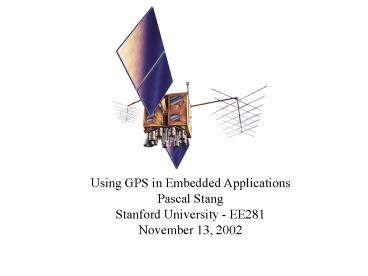Using GPS in Embedded Applications - PowerPoint PPT Presentation
Title:
Using GPS in Embedded Applications
Description:
Using GPS in Embedded Applications Pascal Stang Stanford University - EE281 November 13, 2002 INTRODUCTION Brief history of GPS Transit System NavStar (what we now ... – PowerPoint PPT presentation
Number of Views:198
Avg rating:3.0/5.0
Title: Using GPS in Embedded Applications
1
Using GPS in Embedded Applications Pascal
Stang Stanford University - EE281 November 13,
2002
2
INTRODUCTION
- Brief history of GPS
- Transit System
- NavStar (what we now call GPS)
- Started development in 1973
- First four satellites launched in 1978
- Full Operational Capacity (FOC) reached on July
17, 1995 - System cost of 12 billion
- GPS provides both civilian and military
positioning globally - GPS comprised of three segments
- Space Segment (the satellites)
- Ground Segment (the ground control network)
- User Segment (GPS receivers and their users)
- Selective Availability (S/A) deactivated May 2000
3
GPS SPACE SEGMENT
- GPS Constellation
- 24 satellites (Space Vehicles or SVs)
- 20,200km altitude (12 hour orbit period)
- 6 orbital planes (55 inclination)
- 4 satellites in each plane
- GPS Satellite Details
- Manufactured by Rockwell International, later by
Lockheed MS - 1900 lbs (in orbit)
- 2.2m body, 7m with solar panels
- 7-10 year expected lifetime
4
GPS BLOCK IIR SATELLITE
5
THE GPS SIGNAL
- C/A code and P(Y) code
- All SVs transmit at 1575.42MHz
- Each SV modulates using a unique 1023-bit
pseudorandom (PRN) code sent at 1.023Mcps (chips
per second) - PRN allows spread-spectrum CDMA management of GPS
transmit frequency - Receivers distance to the SV can be determined
by measuring the PRN time skew between the
transmitted and received signals - GPS system data (ephemeris, clock, and
atmospheric parameters) are transmitted by
further modulating the PRN code at 50bps
1023 chips (1ms)
PRN code
1 chip
PRN
PRN
PRN
PRN
PRN
20 codes (20ms)
Data Bits
0
0
1
1
0
0
50bps (20ms/bit)
PRN code inverts to signify bit transition (0/1)
6
HOW TO GET A POSITION
- Need signal from at least four SVs for 3D
position - One SV provides a time reference
- Distance to three remaining SVs is determined by
observing the GPS signal travel time from SV to
the receiver - With three known points, and distances to each,
we can determine the GPS receivers position
(trilateration)
7
EMBEDDED GPS RECEIVERS
- Typical GPS Receivers
- Trimble SK8/ACE GPS receiver (60)
- Garmin GPS35 (160)
- DeLorme Earthmate (85)
- Have seen some as cheap as 50
- Interface
- Single or dual serial port
- Protocols NMEA-0183, TSIP, TAIP, Garmin,
Rockwell Binary, others - Power
- Typical requirements 5V _at_ 200mA
- Where to buy
- Electronics outlets (Frys, GoodGuys, etc)
- Electronic Surplus (Halted, All electronics, etc)
- Internet (where else!?!)
8
GPS RECEIVER RF FRONT END
9
RECEIVER CORRELATOR PROCESSOR
10
NMEA-0183
- National Marine Electronics Association 0183
(NMEA-0183) - (Inter)National standard for navigation data
exchange among marine electronics (GPS, LORAN,
wind/water speed sensors, autopilot, etc) - Adopted by GPS community as defacto standard for
simple output-only Position-Velocity-Time
reporting - Available on nearly every commercial GPS with a
serial port - Uses standard serial port (RS-232C) at 4800,8,N,1
default - Output-only ASCII-only comma-delimited
string-based protocol - NMEA strings
- GPGGA GPS fix data message (lat, lon, time,
SVs, etc) - GPGGL Geographic position (lat, lon, time)
- GPGSA GPS DOP and active satellites (SVs,
P,H,VDOP) - GPGSV GPS satellites in view (SV
elevation/azimuth, SNR, etc) - GPVTG GPS velocity and heading
- GPZDA Time Date message
- NMEA strings are followed by a precisely defined
number of fields which carry the data. Data
recovery can be as easy as using sprintf().
11
TRIMBLE TSIP/TAIP
- Trimble Standard Interface Protocol (TSIP)
- Binary Packet Communications Protocol over
RS-232C (9600,8,O,1 default) - Available on nearly all Trimble GPS products
- Best for complete embedded control of GPS
receiver - Allows reading and control of
- All processed GPS data (position, velocity, time)
- All raw GPS data (pseudoranges, carrier phase,
PDOP, TDOP, signal quality, SVs used, GPS system
messages) - GPS receiver mode parameters (serial port
protocols, DGPS mode, SV selection mode, and
more) - GPS hardware control (oscillator offset,
mixer/integrator control, test modes,
fast-acquisition modes, and more) - Trimble ASCII Interface Protocol (TAIP)
- Provides basic subset of TSIP commands in
ASCII-only format - Great for low-overhead use of GPS receiver in
projects with limited processor speed or RAM - Easy to learn
12
GPS RESOURSES
- Trimble Embedded Receivers
- Spec Sheet http//www.trimble.com/products/catalo
g/oem/lassen2.htm - Full manual ftp//ftp.trimble.com/pub/sct/embedde
d/pubs/lassensk2man.pdf - Includes excellent NMEA, TSIP, and TAIP reference
- Garmin Embedded Receivers
- GPS35 Full manual http//www.garmin.com/manuals/s
pec35.pdf - Stanford GPS courses
- AA272C GPS Theory and Operation
- AA272D Integrated sensor navigation (GPS, INS,
etc) - GPS links
- General Info http//www.gpsy.com/gpsinfo/































